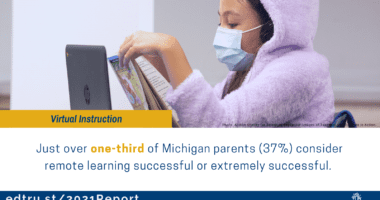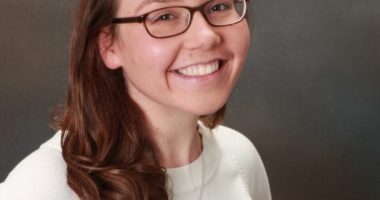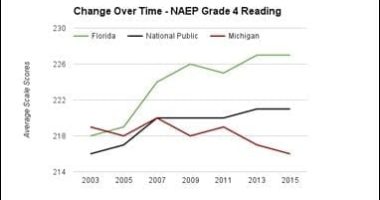The Road to Success in a High-Poverty School: It’s All About Collaboration, Expectations
Godwin Heights Public Schools, MI — In Holly Vostad’s North Godwin Elementary School classroom, kindergarteners sat in circles on the rug, discussing what they planned to write about: A weekend at their father’s. Christmas. Snow. Their favorite things. They soon headed to their desks, pulling out their pencils and got to work on their stories. Even among the students, there’s a lot of collaboration going on at North Godwin.
The students are from diverse ethnic backgrounds, but the vast majority come from low-income families. At North Godwin, one of two Godwin Heights Public Schools elementary buildings, 92 percent of students receive free or reduced-priced lunch. As illustrated in our continuing School News Network series on how poverty affects education, a percentage of low-income students that high is a strong predictor that test scores should be among the lowest in the county.
But that’s not the case. Instead, North Godwin’s scores are soaring. Not only do students in the K-4 school buck the trend that poverty correlates to low achievement. They test so well that they’re on par with West Michigan’s most affluent school districts, East Grand Rapids and Forest Hills.
Last year, 92.2 percent of North Godwin fourth-graders scored proficiently in reading on the MEAP test, and 65.5 percent of third- and fourth-graders were proficient in both reading and math. The state averages are 60 percent and 38.5 percent, respectively. In East Grand Rapids’ Breton Downs Elementary, where just 6.3 percent of students are economically disadvantaged, students’ scores were 92.5 percent proficient in reading and 66 percent proficient in both reading and math.
So how did North Godwin, located in a former car-manufacturing community that has fallen on hard times, do what so many other schools faced with barriers of poverty, student transiency and a high percentage of English language learners haven’t been able to achieve? How have test scores remained consistently high over the past 10 years, setting North as a case study for education professionals interested in turning around low-performing schools?
“There’s a lot of passion here. I love our families and the staff loves our families,” Vostad said. “A lot of times in conferences parents will say, ‘I dropped out of school, but I want better for my child.’ I feel like there’s that desire in the staff to say, ‘You know, they can do better.’”
Staff Mindset is Key
But there’s no magic formula Principal Mary Lang can bottle up and send to other schools. She says the success is the result of a process that requires all teachers to work together with the belief that students can achieve despite their challenging backgrounds. Strong leadership is a must, and data is continually scrutinized.
“It’s a mindset. Everyone believes all children can learn and they believe they will,” Lang said. “It really (has) to do with the staff choosing to come together and work together collaboratively to create the best environment, and create really strong relationships with the community as well.”
Second-grade teacher Kelly Compher agrees staff collaboration is a “huge” factor in student success.
“All the teachers here are 150 percent dedicated to their job and having our students achieve,” Compher said “Everyone is here to support each other, and they all want to see each other succeed. We know our children go through tough times, and we empathize for them, but we don’t let that stop them. We hold them to high expectations.”
Godwin Heights Superintendent William Fetterhoff, who formerly served as North Godwin principal, compares “how they do it” to what a wise fisherman knows.
“Everyone wants to know. ‘What rod are you using?’” Fetterhoff said. “The reality is it’s not about the rod, it’s about the technique — the perseverance to do it over and over again and refine your skill.
“The point is, it doesn’t matter what you use as long as you are consistent, introspective and (willing to modify instruction) for higher-level and lower-level learners.”
The Education Trust-Midwest, a statewide education policy and advocacy organization, in 2009 selected North Godwin as one of its “Dispelling the Myth” schools for high performance in a high-poverty school.
| “If something’s not working or doesn’t meet a curriculum goal, we don’t continue doing it. Teaching is data-driven.” — Holly Vostad |
“What we’ve seen is a real commitment to valuing the importance of teaching, and understanding that teachers are the most important things in school when it comes to student learning and growth,” Winchell Lenhoff said. “They take the development of their teachers very seriously. They are not afraid to have those difficult conversations with teachers if they are not performing as well as they like.”Sarah Winchell Lenhoff, the group’s director of policy and research, cited strong leadership, teacher collaboration and high expectations for students and teachers as key reasons for the school’s success.
The Beginning of Change
North’s transformation from average to exceptional began under Principal Arelis Diaz in the early 2000s. She put a laser-like focus on digging into data, bringing all staff onto the same page and creating a culture where everyone had the same goals. Parent involvement became a huge priority, as did removing long-held beliefs about low-income families.
In 2005, when Diaz left the principal position, her students, including English-language learners and special education students, were outperforming similar students throughout the state. Eighty-five percent of fourth-grade students met or exceeded state reading standards, and 94 percent did so in math. Eighty-seven percent also met or exceeded state writing standards, compared with 50 percent in 2000, while 75 percent of fifth-graders met or exceeded social studies standards.
The district’s dramatic turnaround has earned it statewide recognition for beating the odds and closing achievement gaps.
See story on Arelis Diaz
“Everybody has to hear the same message,” Fetterhoff said. “We used to go to separate trainings and we would exclude teachers if they were special education or ELL. We started bringing everyone in together. … Those specialized teachers were getting the same message and training. It was a double dose for everybody. After a period of time, that led to strong changes in terms of our achievement.”
Accountability increased as well. Consider third-grade teachers comparing scores on a science unit. “They would say, ‘Your kids did much better on that. What did you do differently?’” Fetterhoff said. “Teachers stopped saying, ‘Gosh, I did the best I could,’ and instead looked at their neighbors.”
Vostad explained how that works.
“If something’s not working or doesn’t meet a curriculum goal, we don’t continue doing it. Teaching is data-driven. … Being in the same district years ago, it wasn’t like that. Now, if there’s not an objective behind it, we are not going to waste time doing it.”
The best training teachers can receive is inside their own school building, Fetterhoff said. “Our best professional development is to take a look at our own teachers who are successful and then try to implement those strategies. Two heads are better than one.”
| “Everyone wants to know. ‘What rod are you using?’ The reality is it’s not about the rod, it’s about the technique.” — William Fetterhoff, Godwin Heights superintendent |
“Student teaching was very much like an interview,” said second-grade teacher Compher, who first worked as a student teacher and then a paraprofessional at North. “They were training us to potentially be a candidate for any job that opened. Then, as a parapro, I got to see all grade levels and how they worked with each other.”Student teachers, many who go on to be hired at Godwin, work alongside classroom teachers the entire semester. The new educator benefits from a seasoned teacher’s experiences, and experienced teachers learn new ideas and technology trends in education.
Forming Bonds with Parents
At many low-income schools, teachers cite lack of parental involvement as a major problem. That’s not the case at North Godwin, Compher said. She only had one parent miss fall conferences, which was followed up with a phone conference.
“This community is really great,” Compher said. “The parents want what is best for their kids. Our partnership with them, and relationship with each other, is also what drives the success of our students. I feel like that is a big portion of why our school is successful: because we are trying to reach out to our community. We really push parental involvement.”
The demographics of the Godwin district have changed over the past decade, with many Hispanic families moving into area, said Lang, the principal. The staff embraced them.
“There was tons of work done to build relationships with the Hispanic population,” Lang said. “That helped tremendously as well. We have a a strong Hispanic community and really strong relationships here at North.”
Supporting families goes beyond academics. Vostad noted a teacher who helped a student’s family get rid of lice by visiting their home, and another who studied with a student’s mother to help her take a test to receive her U.S. citizenship.
“We want all of our students to have the same opportunities as kids in other districts,” Compher added. “Coming to our school, we want them to have breakfast, to have their meals. Having their personal needs met is very important for them to be successful.”
In early elementary school, students learn more content than some of their affluent peers. The district implemented all-day kindergarten years before other districts.
“Because our kids come in at a lower level with a lack of background knowledge, I feel like we do have to push a lot more,” Vostad said. She noted educators from other districts would visit and ask, “‘How do your kids know so many sight (beginning reading) words?’ They know 75 to 100. Every school that came said, ‘We only teach 25 or 30.’”
The visiting educators questioned the necessity of teaching so much in kindergarten.
“Our point is: They can do it, so why not? In a lot of districts, they can teach just 25 or 30 and their kids will be just fine, and the scores will be there, because they have that parental support at home,” Vostad said.
“You come to work for us. It’s not enough to stay out of trouble. It’s not enough to not do something wrong. It’s not enough to be average, because we will cut you loose. The strongest tool we have is putting the best people in front of our students. If you are not exceptional, you will not be given tenure in this district.”
“Our kids are tough,” said Lang. “If a teacher can’t manage a classroom, they don’t stick around.”





